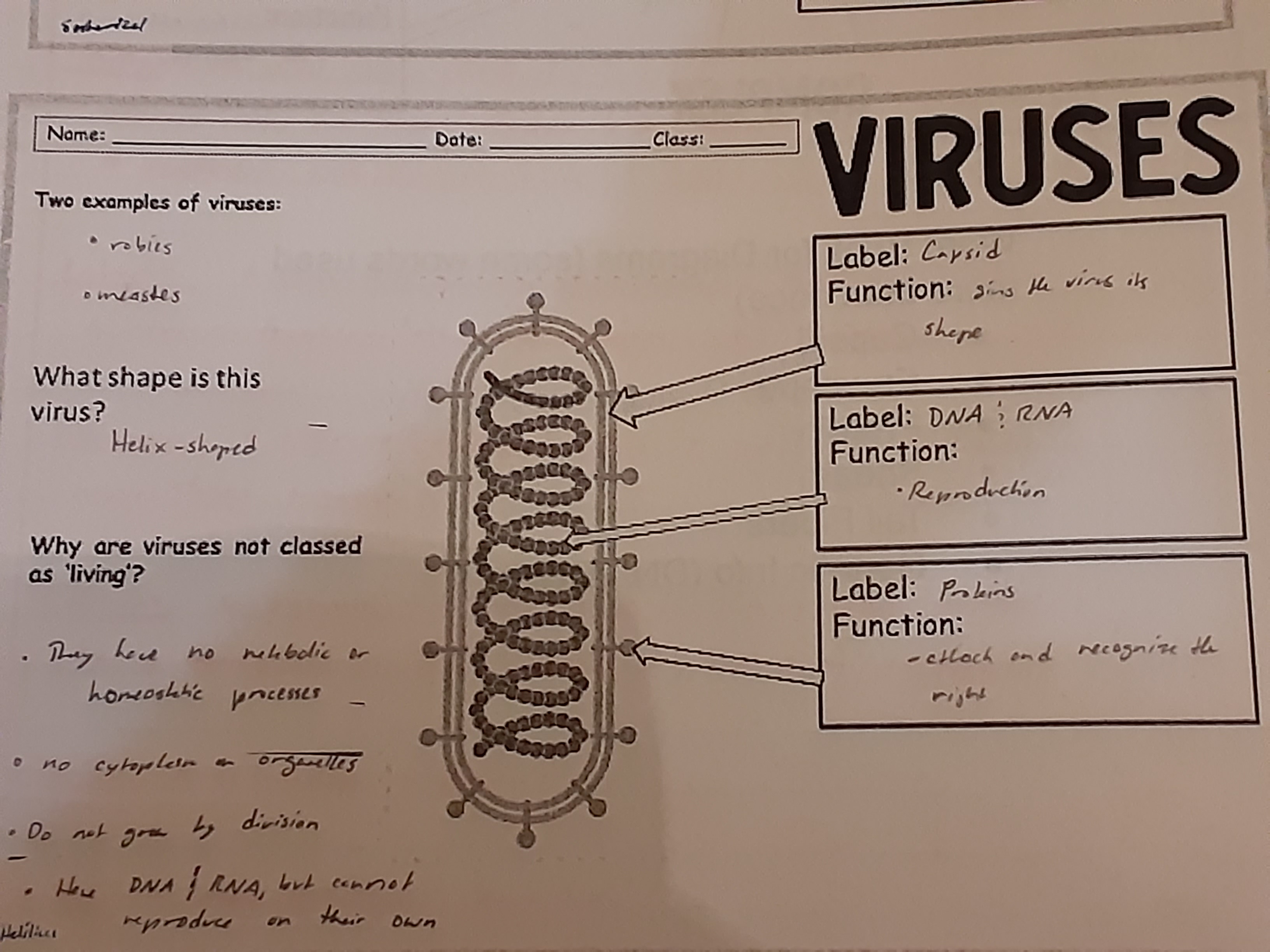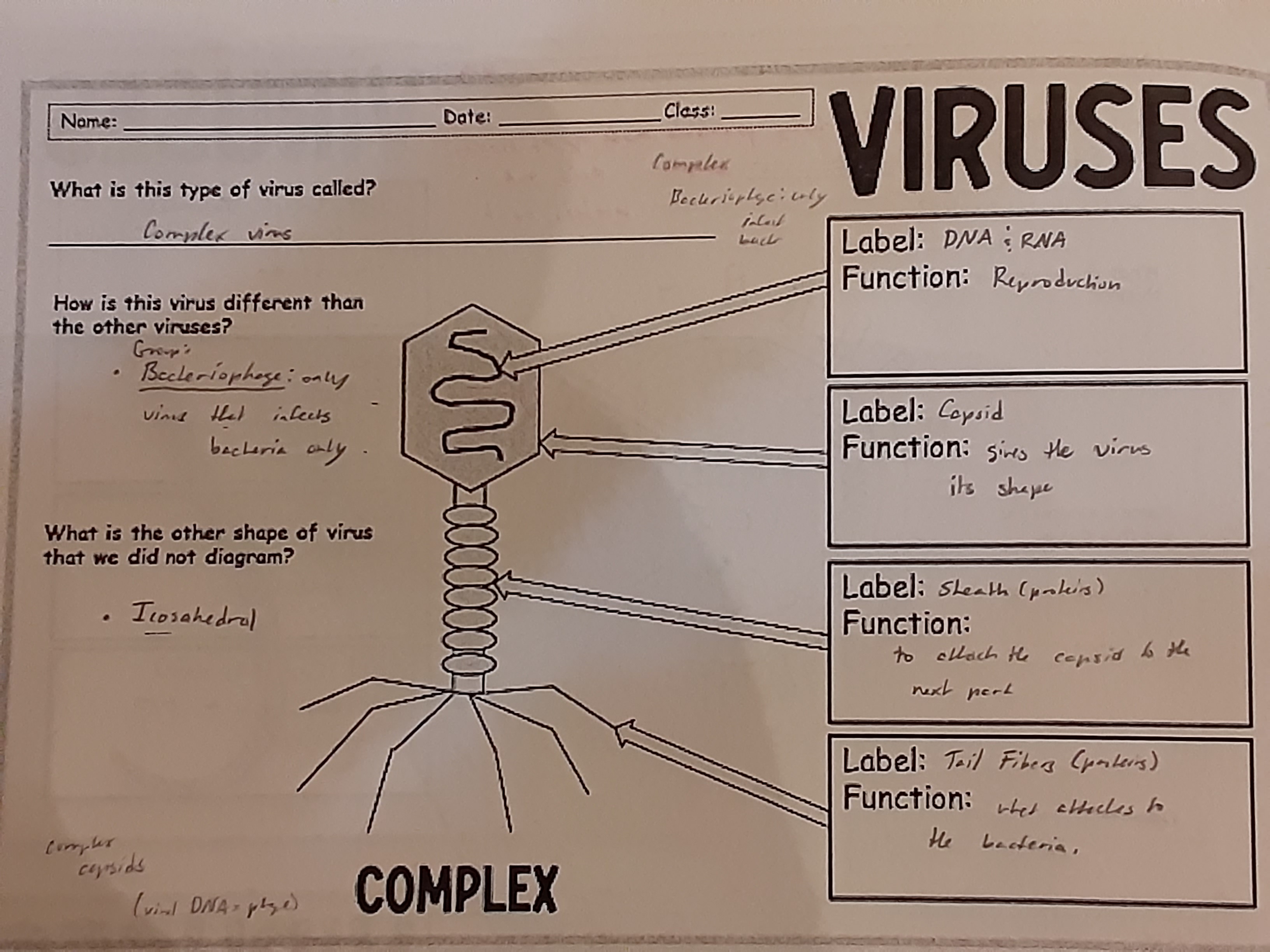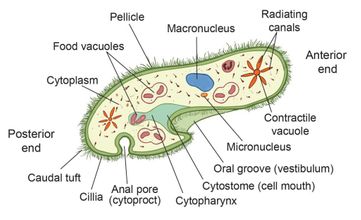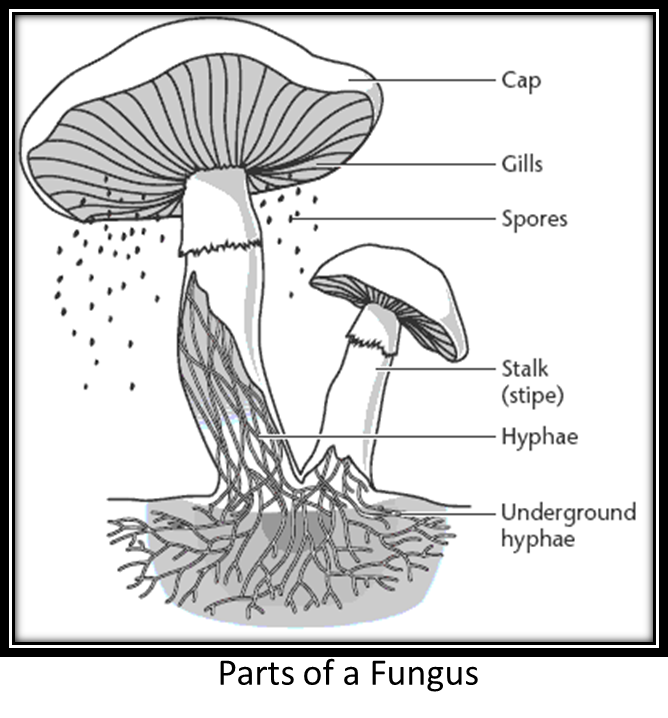Bio 2 Midterm Study Guide
Unit 1: Evolution
Characteristics of First Life on Earth:
- anaerobic
- heterotrophic
- prokaryotes
Early Earth Atmosphere:
- The earth did not have an atmosphere like we think about it today.
- The atmosphere was mostly formed from sulfuric gasses that came from the volcanoes that were present
- Full of sulfur, tons of carbon, and methane with little to no oxygen
Lamarck’s Theory of Evolution:
- French biologist
- He supported the idea that populations changed over time
- Believed in the inheritance of…
- @@Acquired Characteristics@@: individuals could acquire traits/behaviors in their life time and pass them on to their offspring
- Use/disuse: if the individual used the appendages then they would develop further, but if they didn’t they would lose them
- Ex: He believed that elephants used to have short trunks until their food source started to become higher, so they adapted longer trunks in order to acquire food.
- @@This theory of evolution is wrong because while it does rely on some truth in the idea of adapting to the environment, these adaptations do not occur within an individual’s life time. Evolution takes place over generations, not one life span.@@
The word “Fit”:
- @@An Individual being “fit” means that it is able to successfully reproduce and pass on its genes to the next generation because it can live long enough, through its adaptation, in its environment to do so.@@
Types of Natural Selection and Their Graphs:
The three general patterns of Natural Selection:
Stabilizing: individuals with an average form of a trait have the highest fitness
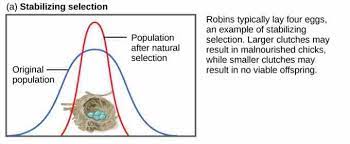
Disruptive: individuals with either extreme variation of the trait have the greatest fitness
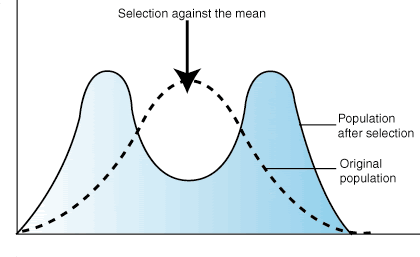
Directional: individuals with one extreme form of a trait have the greatest fitness
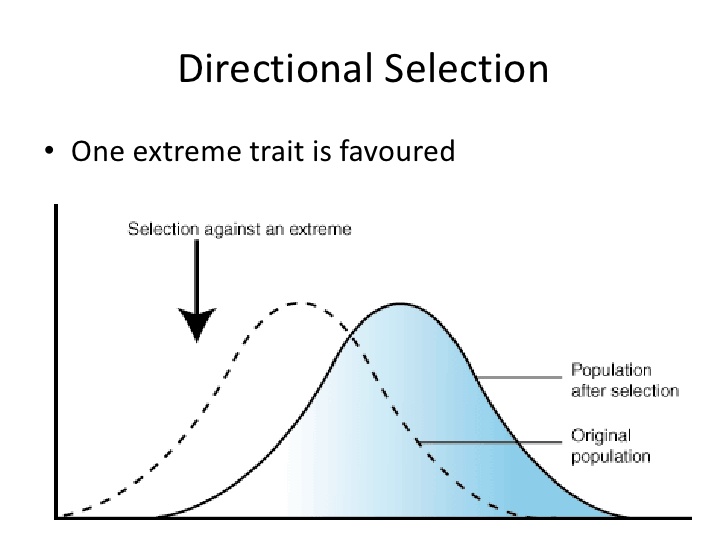
Unit 2: Taxonomy and Kingdoms
The Order of Taxonomic Classification:
- Carolus Linnean developed hierarchical categories according to structure and form
- Modern system has 8 levels
- Largest: Domain
- domain is the most inclusive, species is the most exclusive
- ==Mnemonic: Dirty King Phillip Came Over For Good Soup==
- Domain
- Kingdom
- Phylum
- Class
- Order
- Family
- Genus
- Species
Cladistics/ Cladograms:
==Cladistics **(has traits AND organisms) -==
- Comparative Analysis; ==includes an out group (an organism that is only distantly related to other organisms.==
==*a system of phylogenetic analysis that uses shared and derived character as the only criteria for grouping taxa*==
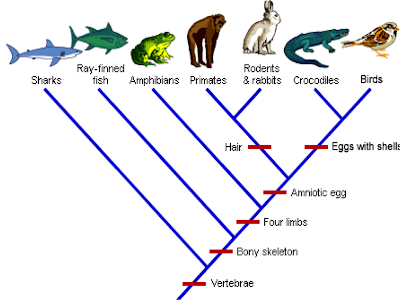

Kingdom Characteristics:
@@Bac@@==teria:==
- ==Eubacteria==:
- ==Aligns with domain Bacteria==
- “true bacteria”
- Lack nucleus, organelles
- Peptidoglycan cell wall
- Unicellular
- Heterotrophic, autotrophic (either chemo or photosynthetic)
- Image
- Archaebacteria:
- Aligns with domain Archae
- Lack nucleus, organelles
- Lacks peptidoglycan in cell wall
- Unicellular
- Heterotrophic, autotrophic (by chemo-synthesis only)
- Image
@@Protista@@:
- @@Domain Eukarya@@
- Not a plant, animal, or fungi
- Eukaryotic
- Complex nucleus, organelles
- Cell wall (usually of cellulose)
- Mostly unicellular, multicellular lack tissue organization
- Autotrophic by photosynthesis, heterotrophic by phagocytosis, or both
- Slime Mold (protista)
- Image
^^Fungi^^:
- ^^Domain Eukarya^^
- 70,000 species
- Eukaryotic
- Complex nucleus, organelles
- Cell wall of chitin
- Unicellular and mostly multicellular
- Heterotrophic by secreting digestive enzymes into environment and absorbing it back in
- Image: Shelf mushrooms
%%Plantae%%:
- %%Domain Eukarya%%
- Mosses, ferns, conifers, and flowering plants
- Eukaryotic
- Complex nucleus, organelles
- Cell wall of cellulose
- Multicellular, develop from embryos
- Autotrophic by photosynthesis
- Image: flower
Unit 3 Part 1- Bacteria and Viruses:
^^Extreme Bacteria: Archaea that live in extreme environments^^
- Cell walls do not contain peptidoglycan
- They contain different amino acids and lipids
- They were first discovered in extreme environments (Extreme Bacteria)
Ex: swamps, hot springs, salt lakes
| Group 1: Methanogens | Group 2: Halophiles | Group 3: Thermoacidophiles |
|---|---|---|
| Convert hydrogen gas and carbon dioxide into methane. | name translates out to “Salt loving” | Serve as producers for communities living at great depth |
| Live in anaerobic environments | Halo: “salt” and phile: “loving” | Acidic environments with high temperatures |
| Habitats: Deep fresh water, marine mud, swamp mud, sewage, cow and termite intestinal tract | Habitats: Great Salt Lakes and Dead Sea | Habitats: Hot springs of Yellow Stone, volcanic vents, hydrothermal vents |
Classification of Bacteria:
Shape:
- Bacilli (rod shaped)
- Coccus (spherical)
- Spirilum (Spiral shaped)
Arrangements:
- Diplo ( in pairs)
- Strepto (in links)
- Staphylo (in clusters)
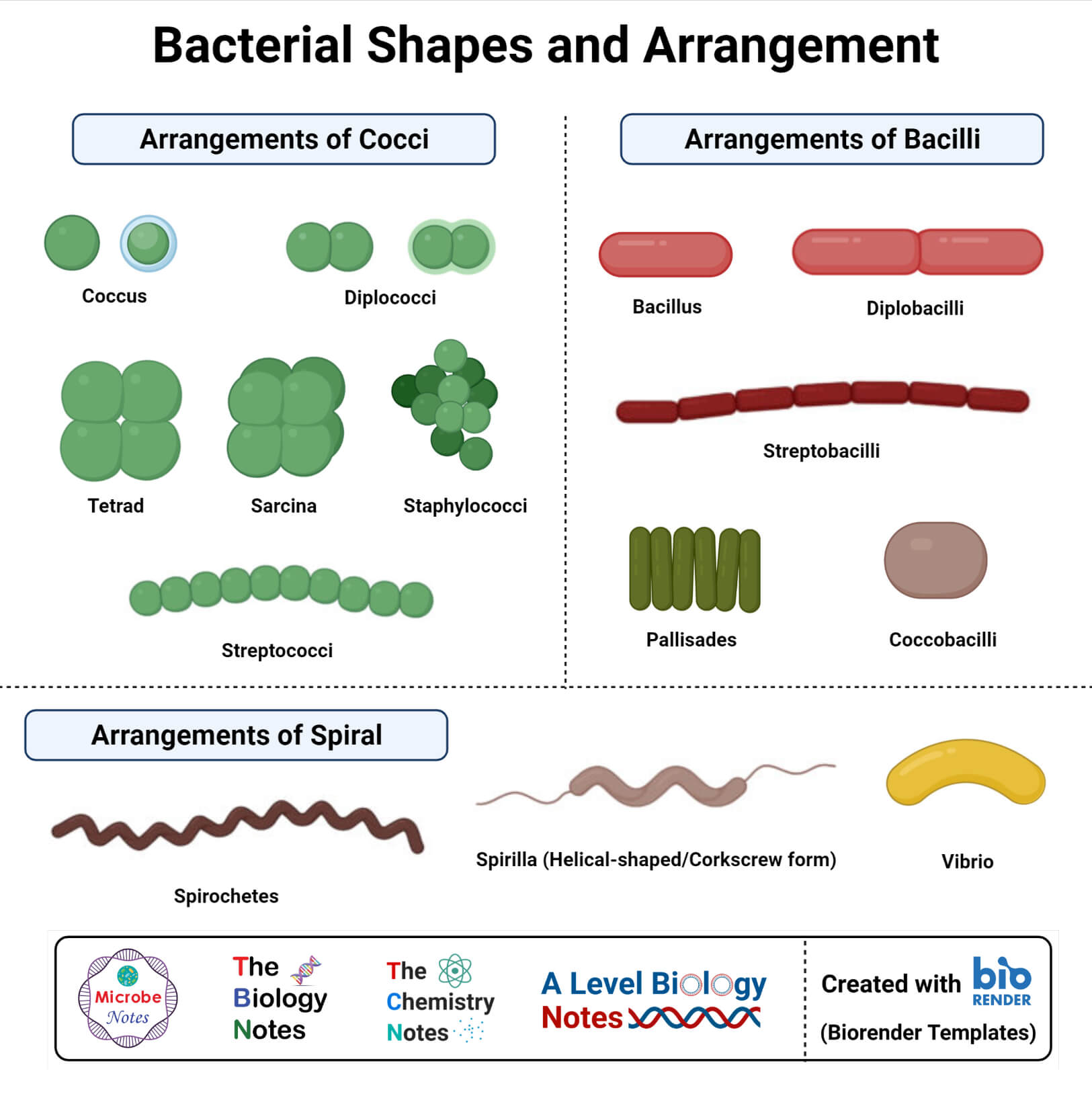
Important Bacterial Groups:
- Proteobacteria (major phylum of Gram Negative bacteria): largest and most diverse group; live symbiotically with other organisms
Ex: Nitrogen fixing bacteria (Rhizobium) in legume roots that transform Nitrogen usable for plants
Gram Negative Bacteria:
- \
Chlamydia: live inside animal cells; no peptidoglycan in cell walls
- Spirochetes: Spiral shaped bacteria; live freely as pathogens; include syphilis and lime disease
^^Gram Positive Bacteria:^^
- Streptococcal species: Botulism (in bad canned foods)
- Streptobacilli species: Includes anthrax and lactobacilli (makes milk sour)
- Actinomycetes: these make antibiotics
Habitats:
Obligate anaerobes: cannot live where oxygen is present
Falculative anaerobes: can live with or without oxygen
Obligate aerobes: need oxygen to live
Cell Walls and Gram Staining:
Gram Positive: Purple (Positive Purple)
- Meaning: The bacteria is of a simpler makeup; it has more peptidoglycan; stains purple
==Gram negative:== Pink
- Meaning: the bacteria is of a more complex makeup; has less peptidoglycan; stains pink
Basic Viral Shapes:
Smallest particles that can cause disease
==Capsid==: protein coat; causes different shapes; helps bond virus to specific host cells
==Shapes:==
==Helix==: (rabies and measles)
==Icosahedron:== 20 triangular faces and 12 corners (chicken pox, adenovirus, and polio)
==Spherical:== influenza virus
Medical Treatment: Bacteria v.s. Virus
Treatment:
Bacteria are treated using antibiotics
Theses antibiotics fight bacterial infections by killing bacteria or making it harder for them to multiply
Actinomycetes: these make antibiotics
Viruses/Viral Infections are treated using vaccines:
- ==mRNA vaccines: Viruses have proteins on their surface that are used to seek out and attach to certain cells==
- mRNA vaccines have the instructions for making the protein found on the surface of the virus that matches the host cell
- the body makes the protein, and then the immune system destroys it
- If infected with the virus again, the body recognizes the proteins and destroys them (therefore destroying the virus)
- THE VACCINE DOES NOT CONTAIN THE VIRUS!!!!!!
- ==mRNA vaccines: Viruses have proteins on their surface that are used to seek out and attach to certain cells==
Prions:
+ infectious protein particles with no DNA or RNA that are misfolded
- ^^Just made up of a capsid (protein^^)
- Example: Mad cow disease
Unit 3 Part 2 - Protists and Fungi:
What characteristics are used to divide protists into 3 classes?
- ==Animal-like protists==
- They are heterotrophic and are capable of movement
- %%Plant-like protists%%
- They consist of single-celled diatoms and multicellular seaweed
- Like plants, algae contain chlorophyll and make food by photosynthesis.
- Fungus-like protists
- They resemble fungi and reproduce with spores as fungi do.
What is the function of contractile vacuole in paramecium?
- Contractile vacuole (sun shaped): collects/disperses water; maintains homeostasis
Animal Like Protists and Their Movements:
- ==Zooflagellates==
- Movement: They swim using ==flagella==
- Can either have 1 or 2
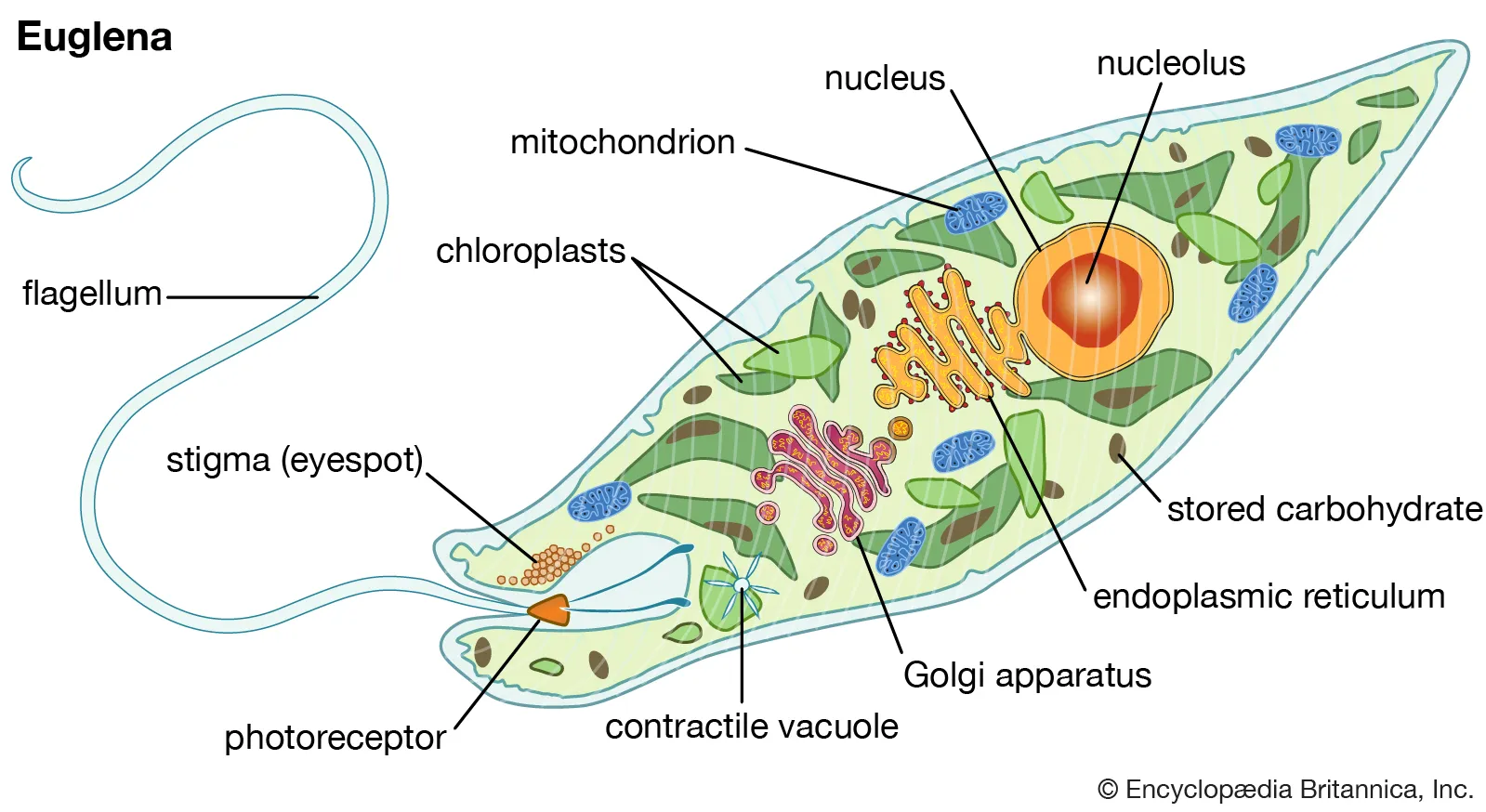
Sarcodines
- Movement: Amoeboid movement
- They capture food with their psuedopods: food vacuole
- %%Ciliates%%
- Movement: They move through the use of %%Cilia%%:
- Hair-like projections that allows the ciliates to move and get food
- ^^Sporozoans^^
- Movement: ^^Do not move on their own^^
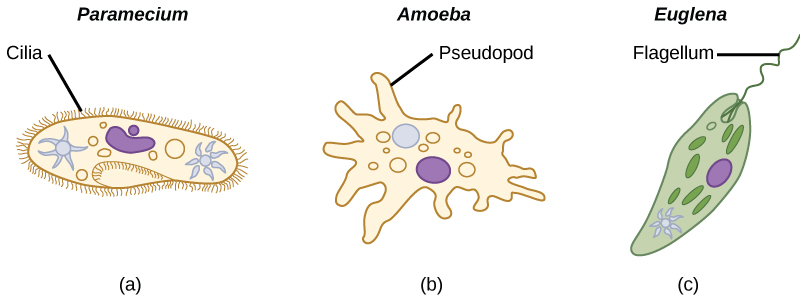
What part of the fungi would you find buried in the ground?
- The mycelium
Absorptive Heterotroph:
- Fungi are considered absorptive heterotrophs: organisms that digest food outside of their body through external digestion in which they excrete acids that break down their food, and then they absorb the matter back into their body.
%%Unit 4: Botany%%
Vascular Tissue Arrangements:
%%Vascular Tissue: transportation system that allows for the movement of fluids against gravity. It is made up of. . .%%
%%Two types:%%
- %%Xylem:%% %%carries water up%%
- %%Phloem: carries nutrients and carbohydrates%%
%%In Monocots:%%
- The vascular bundles are arranged randomly/sporadically in the tissue of the stem
%%In Dicots:%%
The vascular bundles are arranged in a neat line (ring) that follows the circle of the stem
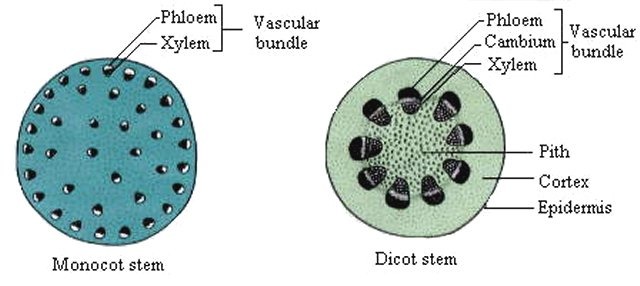
3 Types of Roots:
- Fibrous:
- Formed by many thin, branching roots growing from the stem.
- A fibrous root system is universal in monocotyledon plants and ferns
- Image
- Adventitious:
- Roots formed on the stem and leaf cuttings
Tap:
- One main root that normally shoots straight down and then has other tinier roots growing off of that main root
- More common in dicots (ex: carrots)
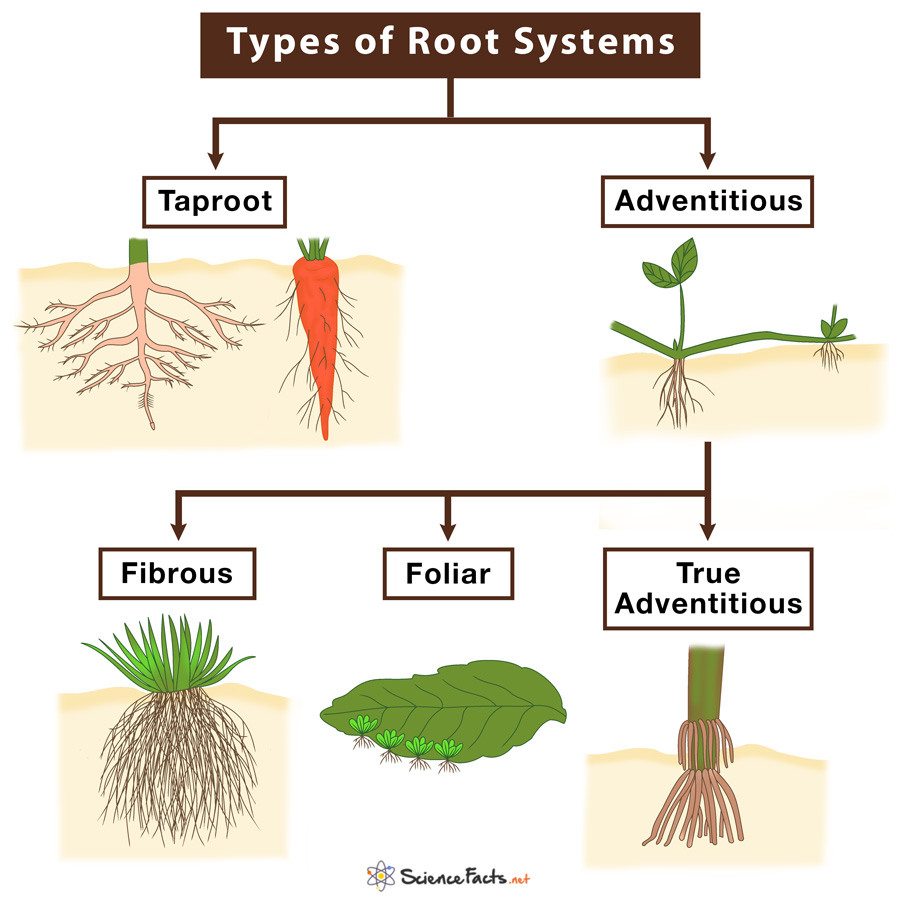
Early Plants:
- Origins in the water (algae)
- First plants evolved from plant-like protists (algae) similar to multicellular green algae of today (chlorophyta)
- Oldest known plant fossil: 450 mya
- Similar to mosses of today
What is an advantage of producing seeds?
- %%One advantage is the fact that the seed covering makes sure that the inside is completely covered, which helps to provide more security of reproduction%%
- The %%seed covering protects the embryo from any harsh environmental conditions%%
- The %%seeds can go into a dormancy period that also allows them to not grow until more suitable environmental conditions come about%%
- They are also %%easily transported%% through the wind and through passing through animal digestive systems
Female and Male Parts of the Flower:
Female parts (Pistil):
- Stigma
- Style
- Ovary
- Ovule
Male parts (Stamen):
- Anther
- Filament
- Flower diagram:
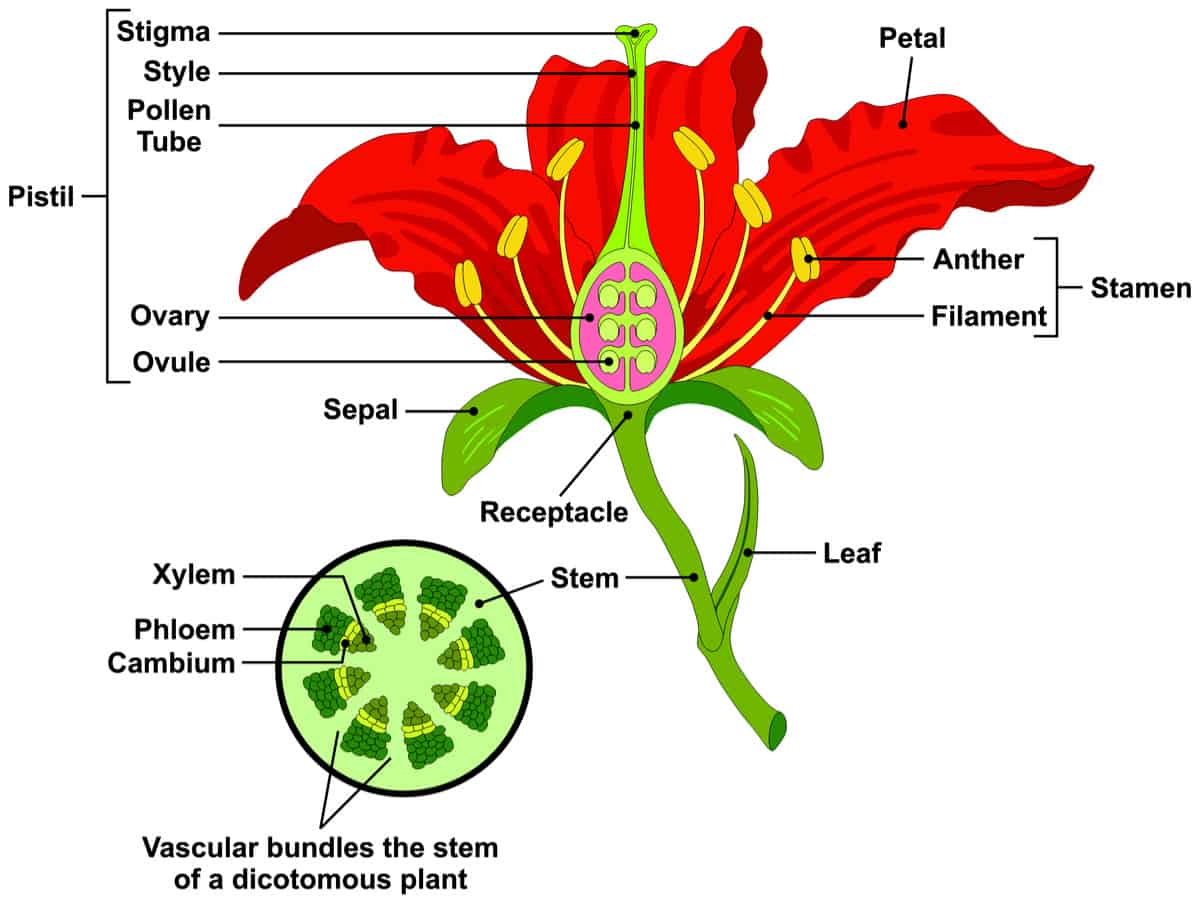
Three Plant Tropisms:
- Phototropism:
- The tendency of a plant to grow towards a light
- Occurs because auxins on the shade sides are stimulated to elongate
- Gravitropism:
- Causes roots to grow downward as gravity pulls them
- Response of a plant to gravity
- Thigmotropism:
- the responding of a plant to environmental stimuli by growing towards or away from them.
Unit 5: Intro to Animals
Major Characteristics That All Animals Share:
- Kingdom Animalia
- So they’ll differentiate on the phylum level
- Multicellular
- Heterotrophic
- Eukaryotic
- Lack cell walls
Characteristics of All Chordates (that they will exhibit at some point in life):
- ==Dorsal hollow nerve cord==: the major cord of nerve fibers running the length of the animal’s body that can develop into the %%spinal chord%% in vertebrates
- ==Notochord==: supporting rod below the nerve cord that gives rise to the %%(intervebral disc)%% in vertebrates
- ==Tail== that extends below the anus that gives rise to the %%(tailbone)%% in vertebrates
- ==Pharyngeal pouches/sacs==: lateral sacs that branch from the pharynx of chordate embryos and may open outside as %%gill slits%% in adult fishes (vertebrates) and invertebrate chordates
Body Symmetry Classification:
Radial: body parts extend outward from the center
- Cnidarians and Echinodermata
Bilateral: body parts have identical left and right sides
- Platyhelminthes, Nematoda, Annelida, Mollsuca, Arthropoda, Invertebrate Chordates, and Vertebrates
Asymmetrical: no symmetry
- Porifera
Differentiation of Germ Layers: (absent, two, or three)
During embryological development, cells begin to differentiate (activate) into three layers (called germ layers)
- Endoderm: Forms digestive and respiratory systems
- Mesoderm: Forms muscular, reproductive, circulatory, and excretory systems (muscles)
- Ectoderm: Forms nervous and integumentary systems (skin/outer covering)
Classifications:
- Diploblastic: having 2 germ layers
- Triploblastic: having 3 germ layers
Invertebrate Phylums and Their Individual Classifications Table:
| Phylum | Example(s) | Germ Layers | Symmetry | Cephalization | Early Development (Blastopore formation) |
|---|---|---|---|---|---|
| Porifera | Sponges | absent | asymmetrical | absent | none |
| Cnidarian | Sea Anemones | two | radial | absent | none |
| Platyhelminth-es | Flatworms | two | bilateral | present | protostome |
| Nematoda | Roundworms | three | bilateral | present | protostome |
| Annelida | Earthworms | three | bilateral | present | protostome |
| Mollusca | Snails | three | bilateral | present | protostome |
| Echinodermata | Starfish | three | radial | absent | deuterostome |
| Arthropoda (Largest Phylum) | Crabs | three | bilateral | present | protostome |
| }}(Not Phylum) Invertebrate Chordates}} | }}Tunicates}} | }}three}} | }}bilateral}} | }}absent}} | }}deuterostome}} |
| }}Vertebrates}}(Not Invertebrates) | }}Birds, Humans}} | }}three}} | }}bilateral}} | }}present}} | }}deuterostome}} |
Levels of Organization:
Cells
Tissue
- Diploblastic or Triploblastic
Organs
Organ systems
Organisms
Simplest animals: just specialized cells to organs to organism
Complex animals: Cell to tissue to organ to system to organism
- Just because an animal is more complex than another does not make it a “better” animal. There is no such thing.
==Body Cavity:== fluid filled space between digestive tract and body wall
Coelem: complex animals have true body cavity completely lined with mesoderm
- <<In coelemates the endoderm forms a circular digestive tube that is surrounded by a thin layer of muscle<<
Psuedocoelem: some invertebrates, only partially lined with mesoderm
- <<In psuedocoelemates the endoderm forms a crescent shape digestive tube<<
Acoelomate: lack coelem between body wall and digestive tract (just a tube of flesh w/ body wall)
<<In acoelomates the endoderm forms a triangular digestive cavity<<
- ==All three germ layers are present in each one (just formed differently)==
==Advantage to having a body cavity: Have room for specialized organs==
Blastopore: Opening in blastula
- Zygote: fertilized egg that gives rise to blastula
Blastula: hollow ball of cells that eventually folds into itself (creating the beginning of a digestive tract)
==Protostome: blastopore gives rise to the mouth==
- invertebrates
==Deuterostome: blastopore gives rise to anus==
- Chordates and echinoderms (starfish)
Segmentation: repeating parts
Segments can become specialized
- Examples: legs, flippers, wings, etc.
Bilaterally symmetrical animals
Invertebrate Characteristics/Overview:
- Lack a backbone or vertebral column
- Includes 33 phyla (largest group)

